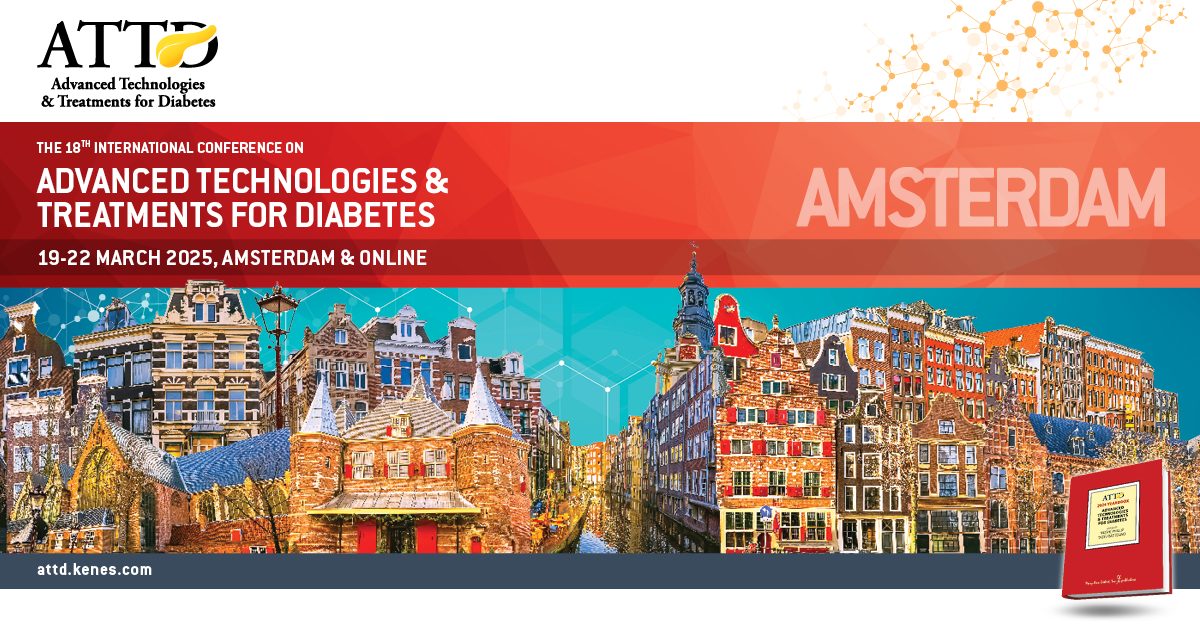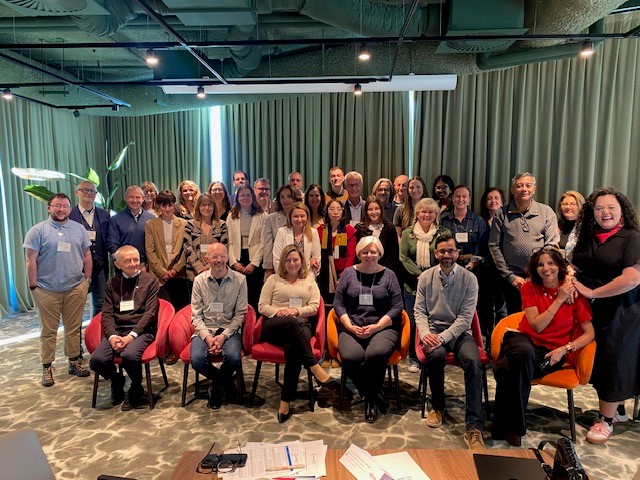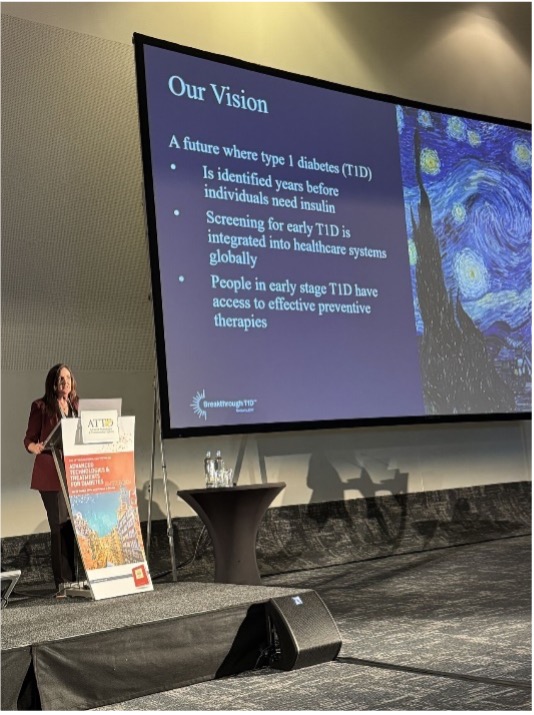
From March 19-22, the world’s leading type 1 diabetes (T1D) researchers—including Breakthrough T1D staff, funded researchers, and partners—gathered in Amsterdam, the Netherlands, for the 2025 Advanced Technologies and Treatments in Diabetes (ATTD) conference. There were dozens of presentations, symposiums, panels and more over the course of the conference, providing a snapshot of the current state of T1D research, management, treatment, and, most importantly, progress towards cures.
Here are a few of the highlights.
Cell therapies
Cell therapies, which place insulin-producing cells into people living with T1D, are a priority of Breakthrough T1D for a simple reason: they have the potential to cure T1D. ATTD covered where cell therapies are on their path toward becoming a reality.

Breakthrough T1D Vice President of Research, Esther Latres, Ph.D., chaired a session on beta cell therapies for T1D. In this session, several researchers funded by Breakthrough T1D, including Andrew Stewart, M.D. (Mount Sinai Icahn School of Medicine), Cristina Nostro, Ph.D. (University of Toronto), Matthias Hebrok, Ph.D. (Helmholtz Munich), and Anath Shalev, M.D. (University of Alabama at Birmingham), discussed their work and the different tactics each are taking.
For example, Dr. Stewart and Dr. Shalev are working on cell survival and regeneration towards identifying ways to protect and prevent the loss of the body’s own beta cells —whereas Dr. Hebrok and Dr. Nostro are working on adapting the immune system to accept and not reject manufactured islet cells after transplantation. Dr. Hebrok is using an elegant approach based on generating chimeric antigen receptor (CAR) T cells to create a localized immune-suppressive environment.
This session highlighted the multiple-shots-on-goal approach required to address the challenge of protecting beta cells from immune-mediated destruction, whether the islet cells are the body’s own that remain at early stages of the disease or are the manufactured islet cells transplanted at later stages.
The speakers at Vertex’s industry symposium emphasized the same key point: the burden of T1D is too high, even with current therapies. Cell therapies can transform how this disease is managed—but they need to be minimally invasive and scalable. (If that sounds familiar, it’s because that’s what Breakthrough T1D is working to create through Project ACT.)
Key Takeaways
The data we have from clinical trials in cell therapies are the case in point for why Breakthrough T1D is prioritizing their development. However, there is still a long way to go before there is a renewable source of manufactured islets. The good news is that there is a lot of momentum around cell therapies, thanks to companies like Vertex, Breakthrough T1D’s Project ACT, and numerous scientists and researchers pushing us closer to our goal.
Using personal experiences to measure the benefits of cell therapies
It is important to understand how a medication, device, or therapeutic procedure (i.e., islet cell transplant) affects the lived experiences of a person. To do this, medical professionals use Person-Reported Outcome and Experience Measures (PROMs and PREMs) to understand how a new therapy influences a person’s day-to-day experience. These assessments generally inquire about how a person with T1D receiving a new therapy feels (stress, anxiety, overall mood), their diabetes management (time spent thinking about or making decisions about the disease), their use of the treatment or device (convenience, effectiveness, intrusiveness), and their overall quality of life (sleep, family life, work, finances, etc.).

Led by Breakthrough T1D Vice President of Research, Esther Latres, Ph.D., and co-organizers from the Breakthrough T1D Advocacy and Medical Affairs teams, Breakthrough T1D organized a PROMs workshop in Cell Therapy to capture meaningful data on a person’s subjective outcomes and experiences. The participants had a diverse range of expertise across the spectrum of T1D management, including people with lived T1D experience and professional and clinical research backgrounds. The one-day workshop focused on identifying what matter most to people living with T1D to inform PROMs assessments. The goal is to ensure that emerging cell therapy treatments and technologies are valued for both improving glycemic outcomes and improving lives.
Key Takeaways
Understanding the lived experience of people with T1D who receive novel cell therapies will be critical to assess what kind of impact they are having on a personal level. People living with T1D and T1D professionals gathered to discuss which factors matter most to people with T1D so the medical community can ask the right questions to those who receive new therapies.
Improving lives
Until we have cures, we need better tools for the millions around the globe living with T1D to lead healthier, fuller lives. That’s the focus of Breakthrough T1D’s Improving Lives portfolio.
Breakthrough T1D Chief Scientific Officer, Sanjoy Dutta, Ph.D., chaired a session on fully closing the loop with automated insulin delivery (AID) systems. (This means systems that require no input from the user.) There are a number of strategies to work towards this, including dual-hormone pumps, DIY systems, and systems that use insulin alone.

Breakthrough T1D Research Director, Jonathan Rosen, Ph.D., moderated a session titled Futuristic Technologies to Improve Outcomes and Quality of Life in Type 1 Diabetes. This session featured some innovative device and drug-device combinations under development for T1D. This includes a miniaturized insulin pump, a CGM combined with a pump into one wearable device, infusion sets made with new materials to promote extended wear, and non-insulin glucose control therapies paired with AID systems to improve outcomes.
Breakthrough T1D Chief Medical Officer International, Thomas Danne, M.D., chaired a panel titled Time in Tight Range: A Crucial Goal or Unnecessary Burden?
Time in Tight Range, which is now referred to as Time in Normal Glycemia (TING), is defined as time spent in a narrower blood glucose range (70-140 mg/dl). To lower the risk of complications as much as possible, we need to help people with T1D get as close as they can to replicating the glycemic range of a person without T1D.
That’s a lofty goal—especially considering that today, with the tools we have, the majority are not spending enough time in a wider range (70-180 mg/dl). This shift towards TING will give people with T1D a better target to aim for and reinforce the notion that we need better tools.
Key Takeaways
AID systems are helping people with T1D achieve better outcomes, but we need more advanced tools to help people achieve tighter glycemic control. We are making progress towards fully closing the loop and utilizing new strategies, like additional drugs, to help people do better until there are cures.
Building consensus for continuous ketone monitoring
Developing continuous ketone monitoring (CKM) systems is one of the current priorities of Breakthrough T1D’s Improving Lives work. It’s important because diabetic ketoacidosis (DKA) remains a significant and dangerous risk for people with T1D. CKMs have the potential to prevent DKA by informing people when ketones are rising so they can take steps to mitigate it before it becomes a crisis.

Additionally, they have the potential to enable safe use of SGLT inhibitors, a class of drugs that has benefits for heart and kidney complications but comes with an increased risk of DKA.
Led by the Medical Affairs team and Chief Medical Officer International, Thomas Danne, M.D., Breakthrough T1D is spearheading the development of an international consensus guidance document around CKM.
These devices are coming, and the medical community needs to be prepared. They will be a first, and there are many things to work out before they’re ready. For example, when should CKMs alert the users? What actions should the users take when the alarms go off? How do we balance real-world use with clinical utility?
These guidelines—and the experts from around the world who attended the meeting—will cover that. Together, they’re working on a manuscript they expect to publish later in 2025.
Key Takeaways
CKMs have the potential to prevent DKA and may allow for the safe use of SGLT inhibitors. To enable safe and effective usage and adoption of CKMs, medical professionals are working together to publish consensus guidelines.
Early detection

In addition to chairing a panel titled Early Detection of Diabetes and Intervention Strategies to Prevent Complications, Breakthrough T1D Associate Vice President of Community Screening and Clinical Trial Education, Anastasia Albanese-O’Neill, Ph.D., also led a symposium that laid out Breakthrough T1D’ s vision for screening and early detection. This session outlined the many components that must be achieved to fully realize our vision of a world without T1D. For early detection of diabetes, that means that research must first provide evidence of the importance and benefits of screening—a task that has been achieved by all the Breakthrough T1D worldwide screening programs—and work closely with regulatory affairs, health policy, and medical affairs to move towards general population screening.
Key Takeaways
We know the benefits of screening and why it’s important to achieve cures. The next step is to increase awareness of these benefits so that more people get screened.
Up next: ADA
The next big meeting is the year’s largest: The American Diabetes Association Annual Scientific Sessions. This meeting will take place from June 20-23 in Chicago, Illinois—and we’ll be there to cover the latest and greatest.